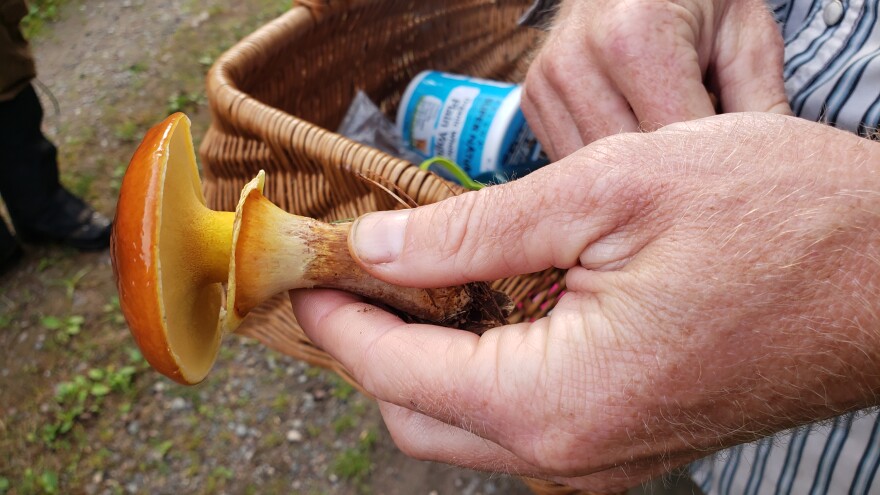A small group of six humans and two dogs make our way down an old logging road.
To not give away anyone’s favorite mushroom foraging spots, all I’ll say is we’re at a State Natural Area in Oneida County.
It’s a cool August morning and after a week of rain, mushrooms of all varieties are starting to pop up.
We don’t make it more than a couple yards down the path before the first one is spotted.
“This is a Suillus. You can feel the cap, they're almost always slippery. When they dry, they're sticky. They're usually called slippery Jacks or slippery Jills,” said Scott Van Egeren. He can identify many of the edible mushrooms that grow in the Northwoods.
“They're just not the greatest tasting things like I don't tend to pick the Suillus and eat much,” he said. “They have kind of like a livery taste like if you'd like that flavor like the Suillus aren't like bad mushrooms. It's just that they're much better ones. I just tend to toss them.”
Van Egeren and Carly Lapin are leading the morning expedition, teaching some of the basics of mushroom foraging. Both have years of experience.
“Just because you can eat it doesn't mean you want to eat it necessarily. You can kind of try different ones and develop or figure out if you like them or not,” said Lapin.

The two take the time to show distinct marks and characteristics on each kind of mushroom that can make them easier to identify.
“You want to usually cut like cut them in half,” said Lapin as she cuts a knife through a white mushroom. “There are a couple of different puffball look-alikes that you want to make sure you don't have. But if they're white and solid on the inside, then they're puffballs. They kind of have like ricotta cheese texture and they take on whatever flavor you cook them.”
Given how dry this summer has been there haven’t been a whole lot of wild mushrooms on the landscape.
Mushrooms thrive in moist environments.
“State natural areas tend to be really good because there's lots of old trees and lots of wood on the ground. But anywhere there's old trails or roads, those are also really good places to look,” said Lapin.
With the recent rainfall, our group ended up finding quite a few varieties like Chanterelles and black trumpets.
“They smell a little bit like blue cheese. They're related to Chanterelles also,” Lapin explained about the black trumpets. “They taste amazing. Like really good.”
Van Egeren and Lapin both say their love of the outdoors and food got them into foraging.
“I like eating mushrooms. I like being outside hiking, and it's a good way for me to slow down because I'm a fast-paced person. It's a nice way to like, just look around and like slow down a little bit,” said Lapin.
“It's the same. I mean, I like eating a lot. There are a lot of edible mushrooms and a variety of flavors and textures. So I like that,” said Van Egeren. “I agree that it's nice to just slowly walk because you can not go very far at all and find lots of mushrooms. And it's nice to look at the small things in the world and notice them.”

They do have some advice for people looking to get started.
Firstly, go out with someone who knows what they’re doing.
Van Egeren learned that one the hard way.
“I listened to some friends who were wrong and ate something that made me sick for a while. So after that, I took some years off and then like actually learned to ID things very well,” he said.
There are groups in the Northwoods like the North State Mycological Club that can help people starting off.
From there, they recommend getting your hands on a good guidebook specific to the region you’re foraging in.
Lapin says to take the time and just learn one or two edible species a year.
“I was just kind of interested in foraging and was with someone we found some morels. And that was really exciting. And then I kind of expanded from there just learning one or two species a year that are edible. And like focusing on those and not into mushroom ID so much is just foraging for edible mushrooms,” said Lapin.
It’s also a good idea to learn the deadly ones. Van Egeren pointed out the Destroy Angel on our hike, a white deadly mushroom found in the Northwoods.
“It's a liver toxin,” he said. “People don't do that much work [to correctly identify it] and they'd cut it in there and then they eat it. Then like you're fine for a couple of days and then your liver dissolves and you die.”
Van Eregen says the death rate used to be closer to 70% if you ate one, but it’s gone down as people have started to recognize it better and catch it more quickly.
Thankfully there are plenty of non-toxic mushrooms in the Northwoods to make up for avoiding ones like that.
And once you do take the time to learn the tasty ones, Van Egeren and Lapin agree you’ll find plenty to add to your favorite dishes.
“We live in a great location for like diversity of mushrooms, we have a really good climate and lots of different habitat types. And that lends itself to finding lots of really cool stuff,” said Lapin.









